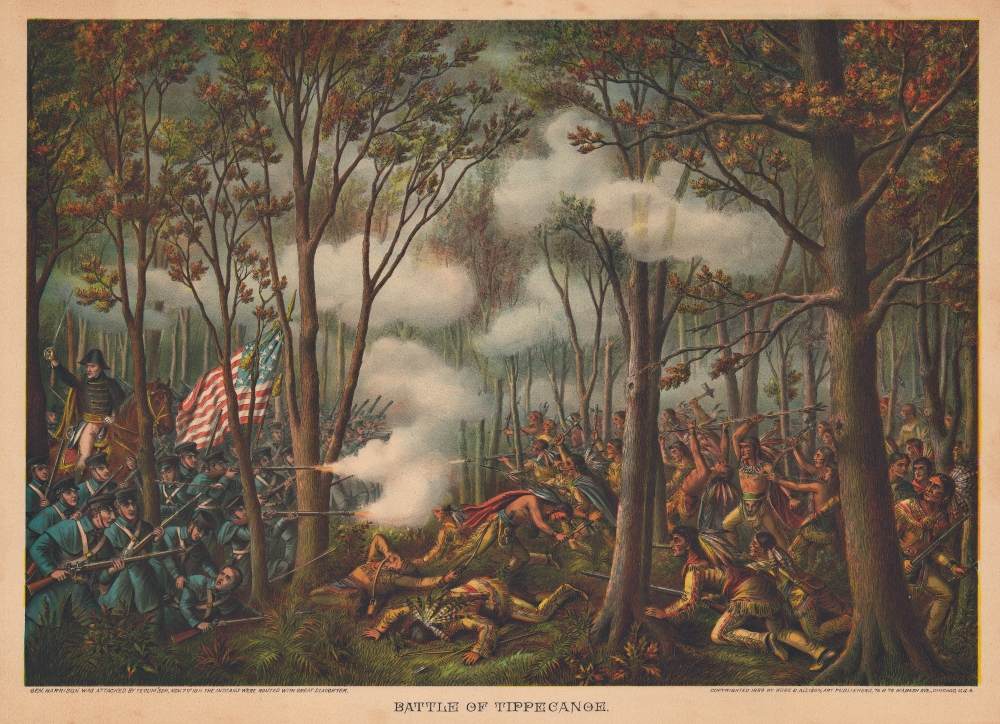1889 Kurz and Allison Chromolithograph View of the Battle of Tippecanoe
BattleTippecanoe-kurzallison-1889
Title
1889 (dated) 18.5 x 25.25 in (46.99 x 64.135 cm)
Description
The Battle of Tippecanoe
The Battle of Tippecanoe took place on November 7, 1811, in Battle Ground, Indiana, along the banks of the Keth-tip-pe-can-nunk River. Hostilities began after Indiana Territorial Governor William Henry Harrison successfully negotiated the Treaty of Fort Wayne, which ceded nearly 3 million acres of Native land to the United States. Tecumseh, leader of the Shawnee, opposed the treaty, and organized a confederacy to fight settler incursions onto Native land. Harrison, for his part, saw all conflicts with Native Americans as hostile and advocated forceful suppression of belligerent tribes. Harrison's froce of 1,000 men marched on Prophetstown, a Native American settlement established by Tecumseh and his brother Tenskwatawa ('The Prophet') at the confluence of the Wabash and Tippecanoe Rivers. When Harrison arrived near Prophetstown, Tecumseh was away but left his brother in charge. Harrison arranged a meeting with Tenskwatawa the following day. HIs forces encamped about a mile from Prophetstown, but his men, fearful of a surprise attack, slept in their uniforms and with rifles loaded. Early the following morning, Tenskwatawa attacked the encamped army. After roughly two hours of fighting, Harrison's men repulsed every attack but suffered 62 deaths and 126 wounded. That night, Tenskwatawa and the other Native inhabitants abandoned Prophetstown and Harrison ordered his men to burn the village.Publication History and Census
This view was created and published by Kurz and Allison in 1889. We note two cataloged examples in OCLC which are part of the collections at the Library of Congress and the Indiana State Library.Cartographer
Kurz and Allison (1880 - c. 1905) was an American publishing firm known for its chromolithographs. Founded by Louis Kurz (1835 - 1921) and Alexander Allison, the firm was based at 267-269 Wabash Avenue in Chicago. In the partnership, it is known that Kurz, an Austrian immigrant, was the lithographer and it is presumed that Allison provided the financial backing. The firm is most well-known for its series of thirty-six battle scenes from the American Civil War. At the time of their publication, the late 1880s and early 1890s, a general nostalgia was prevalent among Civil War veterans (of which Kurz was one), and evidently the company was trying to capitalize on the sentiment. Kurz and Allison's Civil War prints were not the first such prints to be issued, but they were by far the most popular. In a style reminiscent of Currier and Ives, Kurz and Allison lithographs are not meant to be historical representations, and even, from time to time, included historical inaccuracies. Even so, 'prints depicting the Civil War battles by Kurz and Allison are among the most sought-after collectibles of Civil War enthusiasts.' Their prints are also notable for featuring African-American soldiers, a rarity for the era. After the outbreak of the Spanish-American War, the firm published views from famous battles and continued doing so for the campaigns of the Philippine-American War and the Russo-Japanese War. More by this mapmaker...

